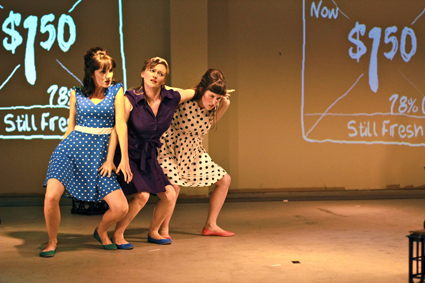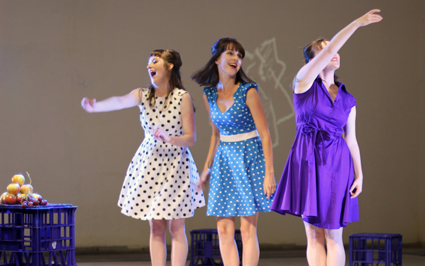 |
Tamara Gazzard, Lucy Shepherd, Sarah Coffee, Spent, Paper Cut Paper Cut Contemporary Performance Collective photo Tahnee McWhirte |
How did the Paper Cut Contemporary Performance Collective come about?
The three of us collaborated as devisers on The Past is a Foreign Country in 2012. This project was initiated by one of our core members, Tamara Gazzard who at the time was doing her Masters of Applied Theatre Studies, conducting practice-based research into self-reflexivity and the verbatim form. We were actually all guinea pigs in her experiment!
We are all interested in exploring verbatim and documentary techniques, but at this stage we aren’t limiting ourselves to that. Our latest work, Spent, for instance, began as a documentary project—collecting discarded grocery receipts and attempting to make performance using only the text found therein. But we also went into it with the question: how can we take a more embodied approach when working within the verbosity of documentary theatre? The final product ended up being much more movement based than documentary.
Generally speaking we want to make contemporary performance that is bold, sharp and playful. We enjoy testing and stretching the boundaries of conventional theatre. We also enjoy making work that has participatory elements—where the audience becomes active in creating the performance with us.
 |
Sarah Coffee, Tamara Gazzard, Lucy Shepherd, Spent, Paper Cut Paper Cut Contemporary Performance Collective photo Tahnee McWhirte |
The Past is a Foreign Country was interesting and unique because it took a mundane little family anecdote, imbued it with profound significance and transformed its retelling into a deep and complex exploration of the notion of absolute truth. After that project, we were excited to discover other ways of making the seemingly insignificant significant. So we stumbled upon the idea of making a show using text found on discarded grocery receipts.
What was the process? Was it different from previous ones?
The process for making Spent involved a lot of research, task-based devising, a couple of development showings and copious rehearsals. It was different to our previous process with The Past… in a number of ways. When we started, we had nothing. At least with The Past… we had an existing narrative to work with. With Spent we just had piles and piles of receipts. Just factual information. We had to speculate and imagine the narratives that tied those facts together. We also had to research in and around the system of consumerism, because there were grand narratives there that impact on the way people shop and what they buy.
The process was also different because the style was different—drawing so much on physical theatre and movement we were challenging ourselves to step out of our comfort zone and express ideas through a different medium from words. We were fortunate to be able to engage a mentor on this project, Cadi McCarthy, who is an established dance theatre artist and choreographer. Cadi stretched and pushed us to find new ways to link text and movement.
The collaborative nature of the process was important. We are committed to working in a democratic way to create new work. We share all of the responsibilities for creating and producing the work, which is really developing our versatility as theatre practitioners. It does bring certain challenges: it can take us days of arguing before we make a concrete decision about something, and it can be scary presenting the work to an audience for the first time without the certainty of having a director tell you exactly what to do.
How did you feel the project turned out? Is there a future for it?
We were all really impressed with how it turned out. It was an ambitious project in many ways—Spent is an hour-long show that features a full-length original sound track created by Huw Jones, accompanying animations designed by Alex Ball and the entire performance is one intricately choreographed movement piece. We also had the challenge of transforming an abandoned shop space at The Store into our performance venue. It took a lot of effort and we’re thrilled that it all came together. We hope there will be a future for Spent. It’s a very portable show, so we’ll be looking into options like touring or an independent season somewhere else.
How do you find making theatre in the context of a regional city
There are many advantages to working here in Newcastle. Space is much more affordable and because there are so few people making new work it’s easier to get noticed. Also, Newcastle hosts one of the nation’s most amazing festivals every year (Crack Theatre Festival as part of TINA), so we have the perfect platform for testing new ideas right on our doorstep.
There are definitely disadvantages as well. Newcastle has a vibrant artistic community and traditional theatre is well respected here. But the kind of performance we make is sometimes met with suspicion. So we have to work really hard to create an audience for our work. We also simply do not have the pathways into the industry that metropolitan areas do. So if you want a career as an artist in Newcastle, your only option is DIY. As emerging artists we’ve benefited from the support of Newcastle’s only funded youth theatre company, Tantrum Youth Arts. This kind of local support is invaluable for emerging artists in regional areas.
What’s in store for the company and you as individual artists?
We have a creative development lined up for later this year for our next work A Minute of Your Time. We’ll also be looking for opportunities to give another life to Spent.
Individually, Tamara has just been announced as a recipient of an ArtStart grant from the Australia Council, so this year will see her developing her creative business through mentoring, professional development and travel. As Tantrum’s Associate Director, Lucy will continue to work on various creative projects for and with young people in Newcastle. Sarah is a member of live art collective Big One Little One and is currently working on a new audio theatre work, I might just take you on the AstroTurf, which will premiere in Bathurst in July.
http://www.papercutpresents.com
RealTime issue #120 April-May 2014 pg. web
© Gail Priest; for permission to reproduce apply to [email protected]








 back
back